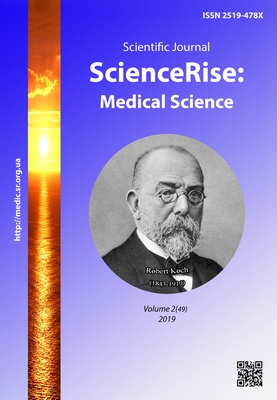Clinical features of heart failure with reduced ejection fraction in patients with obstructive sleep apnea syndrome
DOI:
https://doi.org/10.15587/2519-4798.2019.161853Keywords:
heart failure, obstructive apnea, ejection fractionAbstract
Aim of the research: to estimate the clinical features of chronic heart failure with a reduced ejection fraction in patients with obstructive sleep apnea compared with patients without sleep breathing disorders and to establish the relationships of clinical symptoms, anthropometric dates with the degree of hypoxic disorders during sleep.
Materials and methods. 152 patients with chronic heart failure were enrolled in our open, prospective, non-randomized study. The control group consisted of 57 patients with obstructive sleep apnea without heart failure. A general clinical examination, anthropometric measurements, questionnaires, cardio-respiratory monitoring, echocardiography, the assessment of NT-proBNP were conducted to all participants in the study.
Results. Patients from main group compared with control group were older (by 15.6 %, p<0.05), had a higher body mass index and degree of obesity (by 16,9 %, p<0.05 and 22.1 %, p<0,05), had a longer history of arterial hypertension (by 36.3 %, p<0.01), ischemic heart disease (by 23.6 %, p>0.05), AF (by 16.0 %, p>0.05), diabetes (by 25.3 %, p<0.003). According results of correlation analysis in patients with heart failure and obstructive apnea a significant negative relationship apnea-hypopnea index with age (r=–0.418; p<0.001), ejection fraction (r=–0.376; p<0.01) and a direct link with body mass index (r=+0.512; p<0.003) were found. Mean SaO2 significantly correlated with ejection fraction (r=–0.212; p<0.05), duration of arterial hypertension (r=–0.417; p<0.001), the level of office systolic arterial pressure (r=–0.351; p<0.01) and the level of office diastolic arterial pressure (r=–0.331; p<0.01).
Conclusions. The prevalence of obstructive sleep apnea in patients with heart failure with reduced ejection fraction is 40.1 %, while 55.7 % of patients have severe obstructive sleep apnea. Patients with heart failure with reduced ejection fraction and obstructive sleep apnea are older, have a higher body mass index; they more often have comorbid pathologies in their medical history, namely, arterial hypertension, coronary heart disease, atrium fibrillation, and diabetes mellitus. According results of a correlation analysis, a significant relationships of apnea-hypopnea index with age (r=–0.418; p<0.001), ejection fraction (r=–0.376; p<0.01) and body mass index (r=+0.512 p<0.003) were found
References
- Ponikowski, P., Voors, A. A., Anker, S. D., Bueno, H., Cleland, J. G. F., Coats, A. J. S. et. al. (2016). 2016 ESC Guidelines for the diagnosis and treatment of acute and chronic heart failure. European Heart Journal, 37 (27), 2129–2200. doi: http://doi.org/10.1093/eurheartj/ehw128
- Hamano, J., Tokuda, Y. (2018). Prevalence of obstructive sleep apnea in primary care patients with hypertension. Journal of General and Family Medicine, 20 (1), 39–42. doi: http://doi.org/10.1002/jgf2.214
- Khattak, H. K., Hayat, F., Pamboukian, S. V., Hahn, H. S., Schwartz, B. P., Stein, P. K. (2018). Obstructive Sleep Apnea in Heart Failure: Review of Prevalence, Treatment with Continuous Positive Airway Pressure, and Prognosis. Texas Heart Institute Journal, 45 (3), 151–161. doi: http://doi.org/10.14503/thij-15-5678
- Yoshihisa, A., Takeishi, Y. (2017). Heart failure and sleep disordered breathing. Fukushima Journal of Medical Science, 63 (2), 32–38. doi: http://doi.org/10.5387/fms.2017-13
- Pak, V. M., Strouss, L., Yaggi, H. K., Redeker, N. S., Mohsenin, V., Riegel, B. (2018). Mechanisms of reduced sleepiness symptoms in heart failure and obstructive sleep apnea. Journal of Sleep Research, e12778. doi: http://doi.org/10.1111/jsr.12778
- Diagnosis of Obstructive Sleep Apnea in Adults: A Clinical Practice Guideline From the American College of Physicians (2014). Annals of Internal Medicine, 161 (3), 1–28. doi: http://doi.org/10.7326/p14-9025
- Chung, F., Yang, Y., Brown, R., Liao, P. (2014). Alternative Scoring Models of STOP-Bang Questionnaire Improve Specificity To Detect Undiagnosed Obstructive Sleep Apnea. Journal of Clinical Sleep Medicine, 10, 951–958. doi: http://doi.org/10.5664/jcsm.4022
- Johns, M. W. (1993). Daytime Sleepiness, Snoring, and Obstructive Sleep Apnea. Chest, 103 (1), 30–36. doi: http://doi.org/10.1378/chest.103.1.30
- Reuter, H., Herkenrath, S., Treml, M., Halbach, M., Steven, D., Frank, K. Et. al. (2018). Sleep-disordered breathing in patients with cardiovascular diseases cannot be detected by ESS, STOP-BANG, and Berlin questionnaires. Clinical Research in Cardiology, 107 (11), 1071–1078. doi: http://doi.org/10.1007/s00392-018-1282-7
- Gilat, H., Vinker, S., Buda, I., Soudry, E., Shani, M., Bachar, G. (2014). Obstructive Sleep Apnea and Cardiovascular Comorbidities. Medicine, 93 (9), 45–49. doi: http://doi.org/10.1097/md.0000000000000045
Downloads
Published
How to Cite
Issue
Section
License
Copyright (c) 2019 Dmitro Myrnyi, Iana Andreieva, Mikolay Surmilo, Olha Riznyk

This work is licensed under a Creative Commons Attribution 4.0 International License.
Our journal abides by the Creative Commons CC BY copyright rights and permissions for open access journals.
Authors, who are published in this journal, agree to the following conditions:
1. The authors reserve the right to authorship of the work and pass the first publication right of this work to the journal under the terms of a Creative Commons CC BY, which allows others to freely distribute the published research with the obligatory reference to the authors of the original work and the first publication of the work in this journal.
2. The authors have the right to conclude separate supplement agreements that relate to non-exclusive work distribution in the form in which it has been published by the journal (for example, to upload the work to the online storage of the journal or publish it as part of a monograph), provided that the reference to the first publication of the work in this journal is included.









